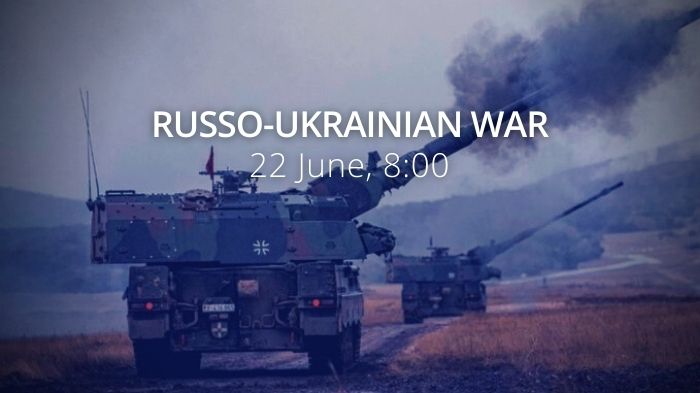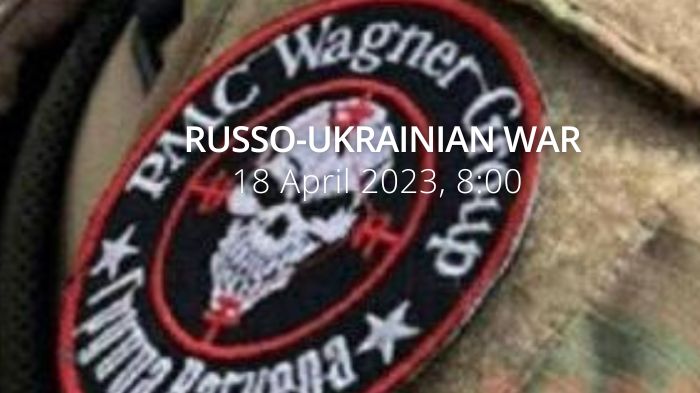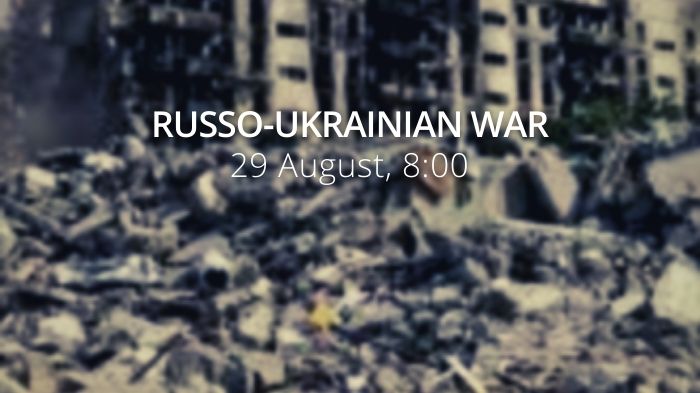Russia conducted the largest missile strike of 2023 on Ukrainian critical infrastructure. 84 different missiles included six hypersonic missiles. Russian missiles damaged energy facilities in 8 regions.
"Russia’s deliberate targeting of civilians and energy grid is a war crime" – EU Commission President https://t.co/BIaOTQSCyE
— Euromaidan Press (@EuromaidanPress) March 9, 2023
Daily overview — Summary report, March 10
A map of the approximate situation on the ground in Ukraine as of 00:00 UTC 10/03/23. pic.twitter.com/BYfkmEWV5k
— War Mapper (@War_Mapper) March 10, 2023
The General Staff’s operational update regarding the Russian invasion as of 18.00 pm, March 10, 2023 is in the dropdown menu below:
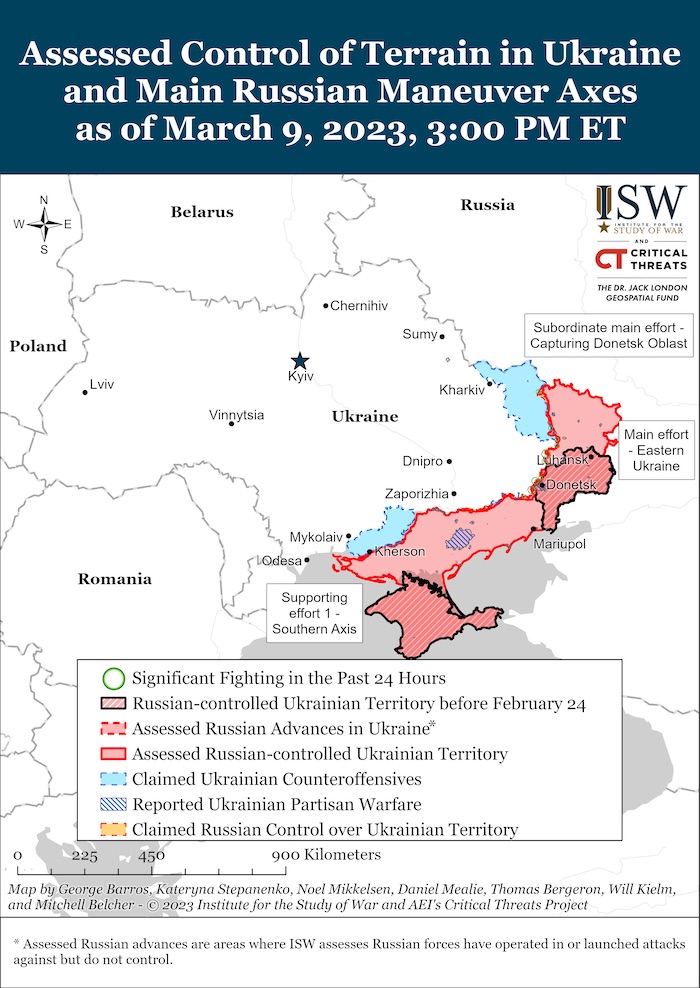
Yesterday, the Russian Federation launched another massive missile attack on the critical infrastructure of our country and the homes of the civilian population. The Russian aggressor does not give up his intentions regarding the occupation of Ukraine. Russian forces continue to use terror tactics, thereby grossly violating the norms of International Humanitarian Law.
In total, during the past day, Russian forces launched 95 missiles. 34 missiles were destroyed by our defenders. Russian forces also carried out 31 air strikes, used 8 Shahed-136 type UAVs, half of which were shot down. Fired 65 rounds from multiple rocket launchers.
The level of missile threat remains high throughout the territory of Ukraine.
[The adversary continues its attempts to surround the city of Bakhmut and to subsequently reach the administrative borders of Donetsk and Luhansk oblasts. The invaders’ main focus is the offensive operations on Kupiansk, Lyman, Bakhmut, Avdiivka, and Shakhtarske axes.] Last day, our soldiers repelled 102 attacks by invaders.
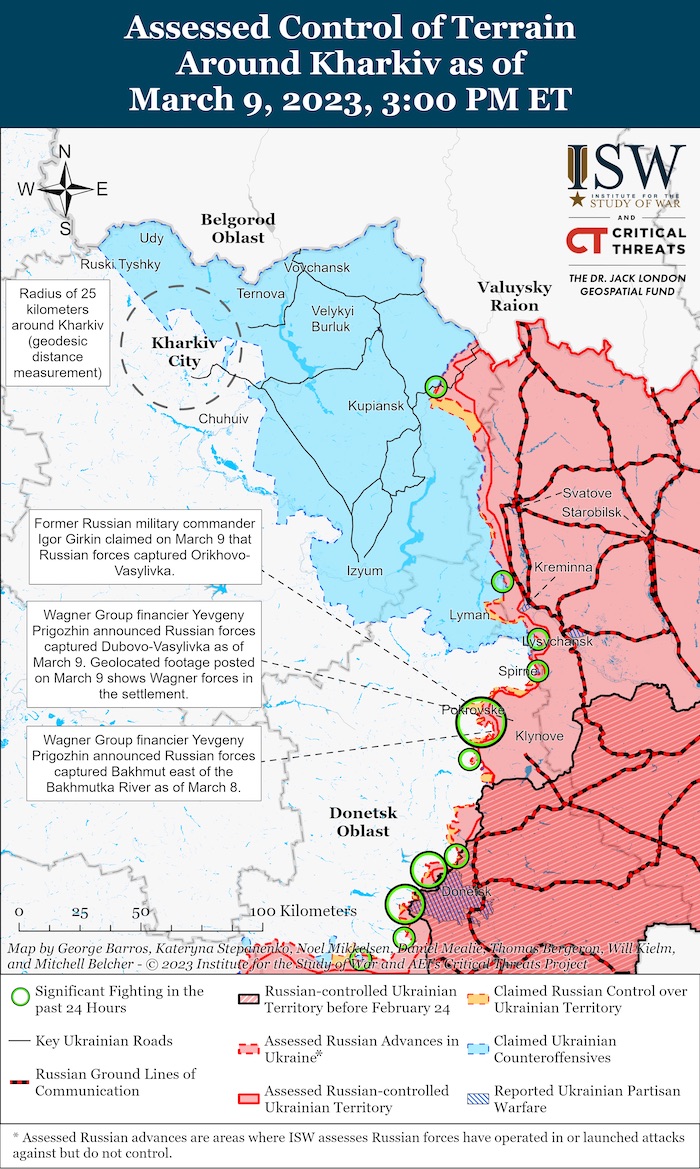
- Volyn, Polissya, Sivershchyna, and Slobozhanshchyna axes: the operational situation has not changed significantly. The Russian Federation maintains a military presence on the territory of the Republic of Belarus, but the formation of offensive groups has not been detected. At the same time, Russian forces continue engineering equipment in the border areas of the Kursk region. During the past day, Russian forces shelled Yelina in the Chernihiv region with artillery; Seredyna-Buda and Atynske – Sumy and Kozach Lopan, Strelecha, Krasne, Vovchansk and Bologivka in Kharkiv Oblast.
- Kupiansk and Lyman axes: Russian forces are trying to improve the tactical position. Shelled, in particular, Novomlynsk, Dvorichna, Hryanikyvka, Zapadne, Kislivka, Krokhmalne and Berestov in the Kharkiv region; Nevsky, Dibrova and Chervonopivka in Luhansk region, as well as Rozdolivka in Donetsk region.
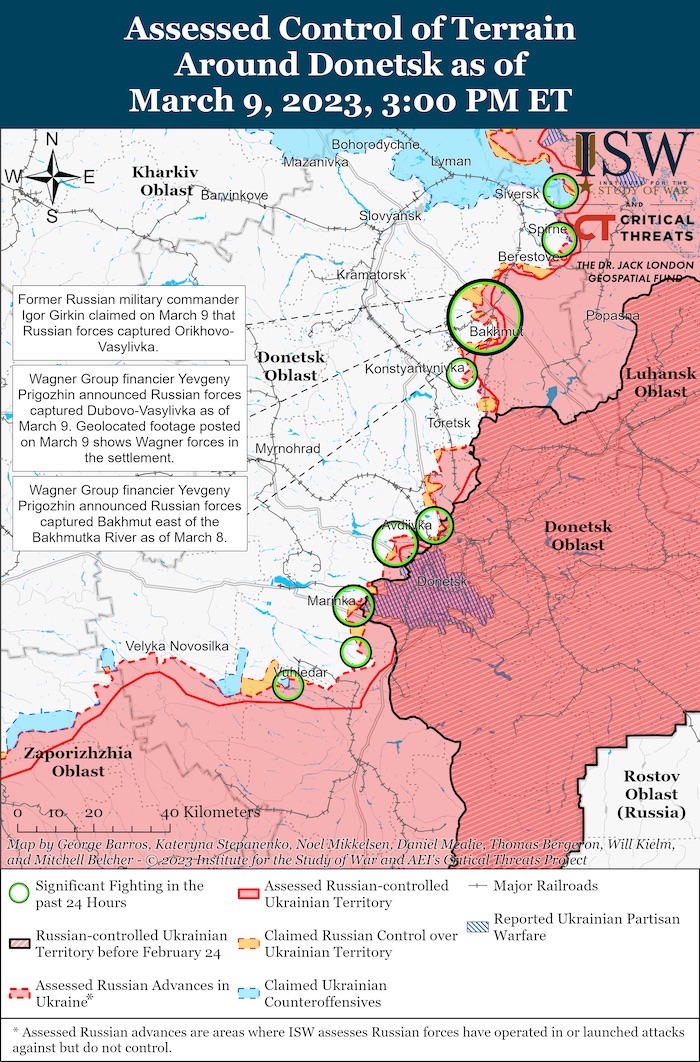
- Bakhmut axis: Russian forces do not stop the assault on the city of Bakhmut. Our defenders repelled numerous attacks in Zaliznyansky, Orihovo-Vasylivka, Dubovo-Vasylivka, Bakhmut, and Ivanivsky districts. Vasyukivka, Zaliznyanske, Minkivka, Dubovo-Vasylivka, Bohdanivka, Bakhmut, Kurdyumivka, Ozaryanivka, and Mayorsk came under enemy fire.
- Avdiivka and Shakhtarske axes: Russian forces carried out unsuccessful offensive actions near the settlements of Krasnohorivka, Kamianka, Vodyane, Severne, Pervomaiske, Nevelske, Mariinka, Pobyeda, Novomykhailivka, and Vugledar of the Donetsk region. Avdiivka, Vodyane, Pervomaiske, Georgiivka, Nevelske, Krasnohorivka, Pobyeda, Vugledar, Prechistivka and Neskuchne came under enemy fire.
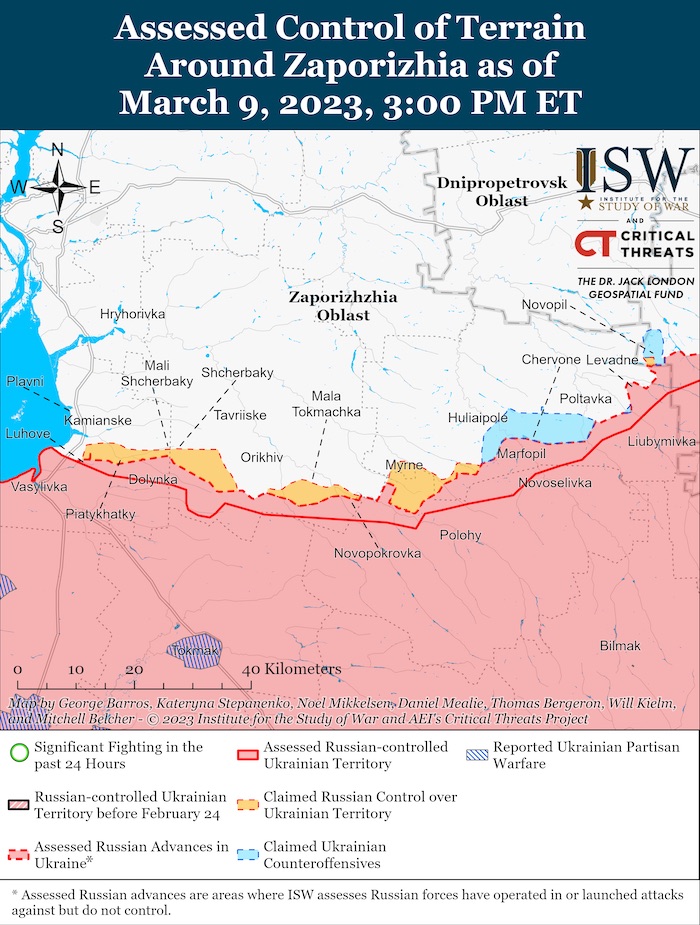
- Zaporizhzhia and Kherson axes: The occupiers are defending Areas of Vremivka, Novosilka and Novopil settlements of Donetsk region were shelled; Gulyaipole, Zaliznychne, Gulyaipilske, Biloghirya, Mala Tokmachka, Novodanilivka, Novoandriivka and Kamianske – Zaporizhzhia, as well as Mykhailivka and Kherson.
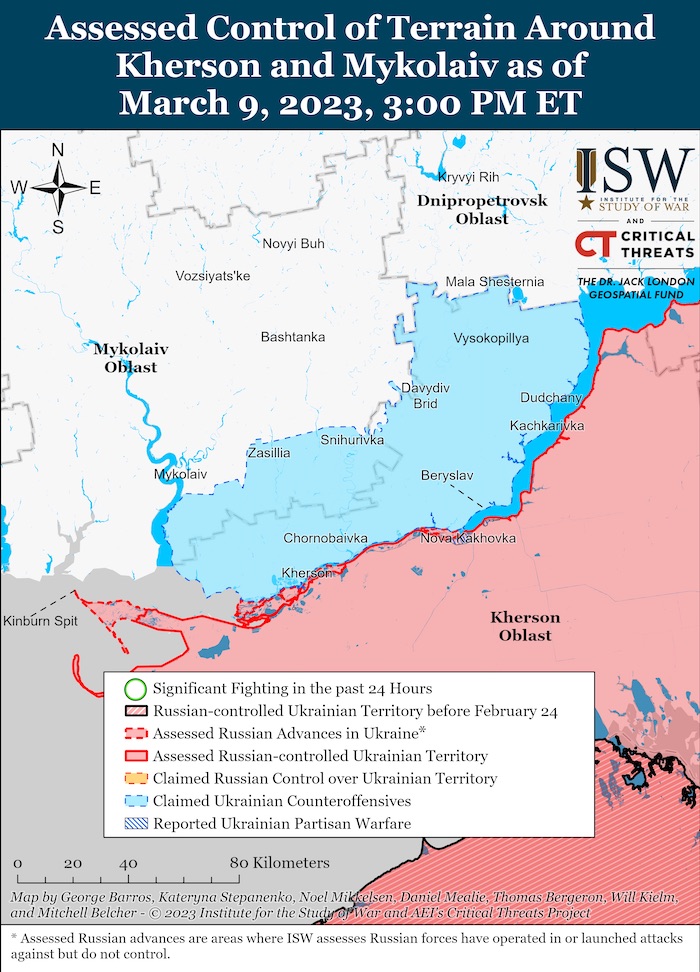
Once again, the Russian invaders, to discredit the Defense Forces of Ukraine, are committing criminal acts in the temporarily captured territories of the Kherson region. This time, residents of the city of Oleshka came under mortar fire from the occupiers.
In Rubizhny, Luhansk region, Russian forces place personnel in residential quarters, hiding behind the civilian population. Military personnel of the occupying forces are housed on the first and second floors, and civilians are left to live above.
[The Russian invaders have intensified looting in certain settlements of the temporarily occupied Kherson oblast. The occupants are taking looted property, and household appliances from Hola Prystan’ and Nova Zbur’ivka using trucks that were used to deliver ammunition to their units.]
Over the past 24 hours, the Ukrainian Air Force has carried out 13 strikes on areas of concentration of personnel and military equipment of the occupiers, as well as a strike on an anti-aircraft missile complex at a firing position.
At the same time, units of missile and artillery troops struck the control post, 6 areas of concentration of enemy personnel, 2 logistics centres, 3 ammunition depots, 6 radio-electronic warfare stations and 2 air defence vehicles in the firing position.
Military Updates
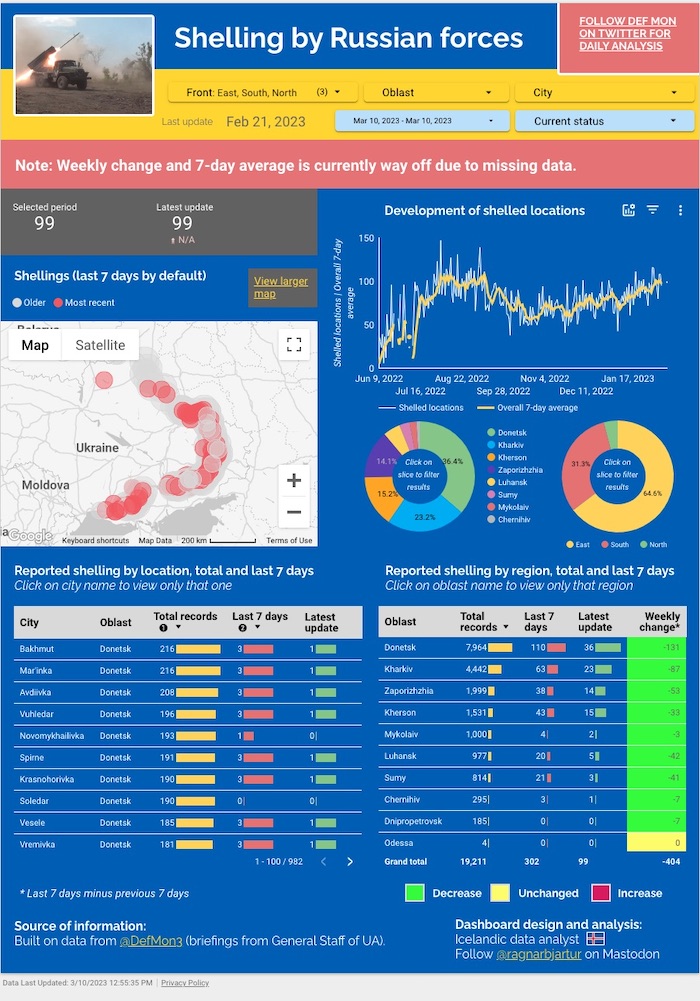
Russia struck Ukraine with 81 missiles Thursday night, including 6 Kinzhal supersonic missiles, Ukrainska Pravda reports, citing Valerii Zaluzhnyi, Commander-in-Chief of the Armed Forces of Ukraine, and Ukrainian Air Force press service. “Russia has fired 81 missiles of various types over Ukraine on the night of 8-9 March, with Ukrainian Air Defence Forces shooting down 34 out of the 48 cruise missiles.
28 launches of Kh-101/Kh-555 air-launched cruise missiles; 20 launches of Kalibr sea-launched cruise missiles; 6 launches of Kh-22 air-launched cruise missiles; 6 launches of Kh-47 Kinzhal air-launched cruise missiles; 8 launches of guided air missiles: two Kh-31P and six X-59; 13 launches of S-300 anti-aircraft guided missiles. In addition, 8 Shahed-136/131 attack UAVs were launched.
Out of the 48 Kh-101/Kh-555 and Kalibr cruise missiles fired, 34 missiles and 4 Shahed-136/131 UAVs were destroyed by Ukrainian Air Force assets and personnel, in cooperation with units of other Defence Forces of Ukraine”. As a result of organised countermeasures, 8 Kh-31P and Kh-59 guided air missiles did not reach their targets. The Air Force notes that the Ukrainian Armed Forces lack the means to destroy Kh-22, Kh-47 Kinzhal and S-300 missiles.”
Relevance of Bakhmut’s defence only increases – Commander of Ukraine’s Ground Forces, Ukrainska Pravda reports, citing the Press office of the Ukrainian Ground Forces. “Oleksandr Syrskyi, Commander of the Ukrainian Ground Forces, has stated that the relevance of continuing the defence of Bakhmut in Donetsk Oblast is only increasing. Every day of the city’s defence allows us to win time to prepare reserves and prepare for future offensive operations. At the same time, in their fight for this fortress, Russian forces are losing the most prepared and capable part of their army – the Wagner [Group’s] assault units.”
Defence forces aware of enemy’s plans in Bakhmut front, Ukrinform reports. “Defence is the organization of actions built on strategy, discipline, and trust of personnel. Its success depends on the intelligence and cunning of each commander. We must be able to anticipate the actions of Russian forces who have a numerical advantage. The defence of Bakhmut has been ongoing for almost 10 months. The defence forces took a number of tactical steps which prevented Russian forces from encircling Bakhmut so far, but the situation is still very difficult,” Colonel General Oleksandr Syrskyi, the Commander of the Ukrainian Ground Forces.
According to him, the Russian forces operate by usual methods, they do not count people, but the number of soldiers is not a decisive advantage or a factor of victory. We realize the tactical importance of Bakhmut for Russian forces and are aware of their plans for action in other areas of the front. The defence forces continue to defend the city. The situation is dynamic. Here, every move and decision may change it radically, the commander emphasized.”
Kremlin’s Trojan dove: how Russia uses “peace” to aid its war against Ukraine
According to British Defence Intelligence, (last 48 hours):
- On 09 March 2023, Russia conducted a wave of at least 80 long-range strikes against Ukrainian critical infrastructure. Russia deployed cruise missiles, air defence missiles in a surface-surface role, Iranian one-way attack uncrewed aerial vehicles, and an unusually large number of hypersonic air-launched ballistic missiles during the attack.
- This was the first major wave of long-range strikes since 16 February 2023 and likely one of the largest since December 2022. Ukrainian officials reported at least 11 civilians killed.
- The interval between waves of strikes is probably growing because Russia now needs to stockpile a critical mass of newly produced missiles directly from industry before it can resource a strike big enough to credibly overwhelm Ukrainian air defences.
- On 07 March 2023, Belarusian President Alexandr Lukashenko confirmed that one of Russia’s small fleet of A-50U MAINSTAY D airborne early warning and control aircraft deployed in Belarus had been damaged. The aircraft was almost certainly attacked by a small uncrewed air system.
- The MAINSTAY has likely now been moved to a repair facility at Taganrog in Russia. The transit flight reportedly took place at a lower than usual altitude, likely because of damage to the pressurised cabin.
- The MAINSTAY was likely providing situational awareness for MiG-31K FOXHOUND D fighter aircraft modified to launch the AS-24 KILLJOY air launched ballistic missile which Russia sees as a key strategic capability. The modification saw the jets’ internal radar removed to balance the airframe, making pilots reliant on external sources of situational awareness, such as MAINSTAY. It is a realistic possibility that joint Russo-Belarusian air activity will now be forced to rely on ground control and fighter escort until another MAINSTAY can be deployed.
Losses of the Russian army
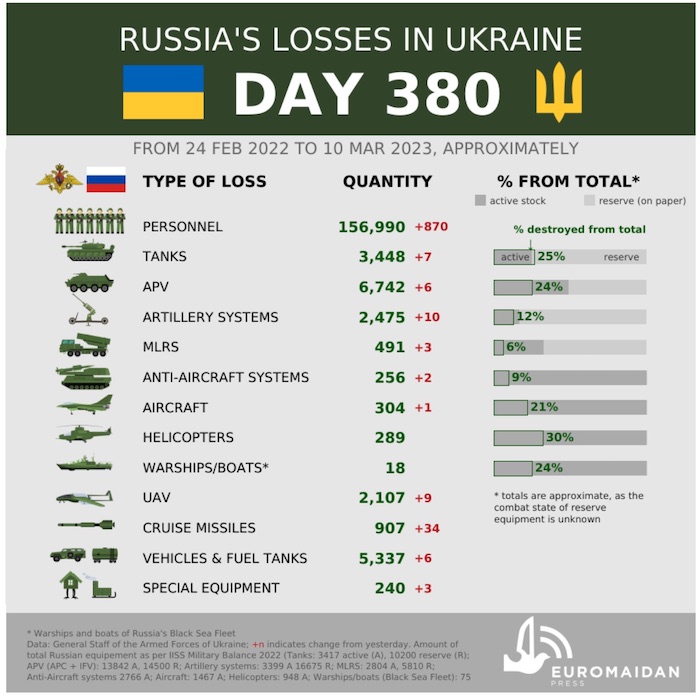
- Personnel – about 156990 (+870)
- Tanks – 3448 (+7)
- Armoured combat vehicles – 6742 (+6)
- Artillery systems – 2475 (+10)
- Multiple rocket launchers –MLRS – 491 (+3)
- Air defence means – 256 (+2)
- Aircraft – 304 (+1)
- Helicopters – 289 (+0)
- Automotive technology and fuel tanks – 5337 (+6)
- Vessels/boats – 18 (+0)
- UAV operational and tactical level – 2107 (+9)
- Special equipment – 240 (+3)
- Mobile SRBM system – 4 (+0)
- Cruise missiles – 907 (+34)
Russia is running out of ammunition, the Ukrainian General Staff reports. “The armed forces of the Russian Federation have almost used up the entire stock of artillery ammunition kept in storages in the central part of Russia. Nowadays, we observe movement of ammunition from depots located in other oblasts of Russia to the temporarily occupied territories of Ukraine.
There is also an unsatisfactory state and quality of new batches of ammunition due to improper storage and violation of service rules and regulations. Almost 50% of them have visible signs of rust damage. In the conditions of intense hostilities and the existing unsatisfactory state of ammunition, one should expect their shortage in the artillery units of the Russian army within the next 2-3 months.
Iran sent Russia over 100 million rounds of ammo, plans to send more, The Jerusalem Post reports. “Iran has provided Russia with about 100 million bullets, 300,000 artillery shells and ammunition for rocket launchers, grenades and mortars and is planning to send more ammunition, Sky News reported on Wednesday, citing a security source.
The source said that two Russian cargo ships left a port in Iran in January, transporting the ammunition to Russia via the Caspian Sea and that Russia had paid for the material in cash.”
Defence Intelligence reports quantity of Russian military equipment tracked by “people’s satellite” ICEYE, Ukrainska Pravda reports, citing Defence Intelligence of Ukraine. “Ukrainian Defence Intelligence started using the “people’s satellite” on 24 September 2022. Since then, the Security and Defence Forces of Ukraine have been receiving necessary data from space daily. In five months of using ICEYE, members of Ukrainian Defence Intelligence have conducted space radar reconnaissance in almost 1,000 areas of deployment of military units of the aggressor state in the temporarily occupied territories and other territories of interest to the Armed Forces of Ukraine.
During this time, the resources of the spacecraft have allowed the Armed Forces of Ukraine to detect 360 tents in areas where the Russian occupying army was deployed, as well as 7,321 pieces of Russian military and special equipment, specifically: 45 planes; 27 helicopters; 6 Iskander mobile short-range ballistic missile systems; 36 S-300 anti-aircraft systems; 12 Pantsir S1 missile systems; 11 radar stations; and 10 pontoon bridges. […]
On 18 August 2022, Serhii Prytula, Ukrainian comedian, TV-host and activist, reported that his foundation had purchased a satellite and access to a satellite imagery database for the Ukrainian army for more than a year for 600 million hryvnias raised by Ukrainians.”
Humanitarian
https://twitter.com/EuromaidanPress/status/1633980328011350019
Russian missiles damaged energy facilities in 8 regions last night, Ukrainska Pravda reports, citing Denys Shmyhal, Prime Minister of Ukraine. “As a result of missile attacks by Russia on the night of 8-9 March, energy production and distribution facilities were damaged in eight regions of Ukraine. […] Mainly the energy system of Ukraine was targeted. They tried to destroy it again. And failed again. The energy systems remain intact. Temporary electricity shutdowns might happen in some areas, since energy production and distribution facilities were damaged in eight regions.
- As a result of this large-scale missile attack, the city of Kharkivwas left without electricity, water and heat, 40% of Kyiv residents were left without heating, and there were restrictions on electricity supply in the city of Odesa and Odesa Oblast.
- In Kyiv Oblast, emergency shutdowns of electricity were introduced, but they were quickly cancelled.
- In addition, due to the attack by Shakheds, the city of Zhytomyr experienced power outages, electric transport was stopped there, and the city was left without water.
- Russian forces have attacked DnipropetrovskOblast with drones and missiles.
- In Zaporizhzhia Oblast, five missiles hit a critical infrastructure facility.
- In Odesa Oblast, missiles hit an energy infrastructure facility, and residential buildings were damaged.
- There were also hits on an energy facility in Ivano-Frankivsk Oblast.
- In Lviv Oblast, houses were destroyed and five people were killed, but the missile attack did not affect the energy situation in the oblast.
Most difficult energy situation in Kharkiv and Zhytomyr regions, Ukrinform reports, citing President Zelensky. “Restoration work at power facilities has been ongoing all day. Kharkiv and the Zhytomyr region have the most difficult situation. Odesa, the Dnipropetrovsk region, Kyiv and Zaporizhzhia are also facing difficulties, he said.”
Russia raises doubts about grain deal renewal as deadline looms, Reuters reports. “The Black Sea Grain Initiative, brokered by the United Nations and Türkiye last July, aimed to prevent a global food crisis by allowing Ukrainian grain blockaded by Russia’s invasion to be safely exported from three Ukrainian ports.
The deal was extended for 120 days in November and will renew on March 18 if no party objects. However Moscow has already signalled it will only agree to an extension if restrictions affecting its own exports are lifted. Russia’s agricultural exports have not been explicitly targeted by the West, but Moscow says sanctions on its payments, logistics and insurance industries are a barrier to it being able to export its own grains and fertilisers.”
790 ships have gone through ‘grain corridor’, Türkiye says, Ukrinform reports. “To date, 790 ships have already gone through the “grain corridor” in the Black Sea. According to Defense Minister of Türkiye Hulusi Akar, the volume of grain shipments (wheat, corn, and barley), exceeded 23 million 400 thousand tonnes.
At the same time, 40% of the grain was transported to Europe, 30% – to Asia, 13% – to Türkiye, 12% – to Africa, and 5% – to the countries of the Middle East, Hürriyet reports.”
Environmental
Ukrenergo resumes Zaporizhzhia Nuclear Power Plant power supply after Russian missile attack, Ukrainska Pravda reports, citing Ukrenergo. “Experts of the Ukrainian power company Ukrenergo resumed the power supply of the Zaporizhzhia Nuclear Power Plant (ZNPP), interrupted by Russian missile attacks on 9 March. The ZNPP switches from diesel generators to receiving energy for its own needs from the United energy system of Ukraine, it is stated in the company’s report.
The ZNPP was completely cut off from the power grid due to a Russian missile attack which was launched on 8 March at night, threatening an accident with radioactive consequences for the entire world.”
IAEA chief makes plea for Zaporizhzhia safe zone after outage, Reuters reports. “UN nuclear watchdog chief Rafael Grossi on Thursday appealed for a protection zone around the Russian-held Zaporizhzhia nuclear power plant in Ukraine after another outage there, saying he was astonished by the complacency around the issue. Each time we are rolling a dice. And if we allow this to continue time after time then one day our luck will run out, Grossi told the IAEA’s 35-nation Board of Governors.
Europe’s biggest nuclear power plant lost its last external power line early on Thursday after missile strikes across Ukraine overnight. The plant is now down to emergency diesel generators, a last line of defence to keep cooling reactor fuel and prevent a potentially catastrophic meltdown.”
Euratom and 49 countries demand that Russia leave Zaporizhzhia Nuclear Power Plant, Ukrainska Pravda report, citing Prime Minister Denys Shmyhal, “The risks at the Zaporizhzhia NPP remain high as long as the Russian military and Rosatom personnel are at the station. Russia must leave the ZNPP. Today, 49 states and Euroatom came to the Board of Directors of the IAEA with this statement, he wrote.
They also called on Russia to stop shelling Ukrainian energy facilities and noted the importance of regaining Ukraine’s control over all nuclear facilities within internationally limited borders. Only this will ensure their safety and security. Also, international delegations insist on holding Russia responsible for its repeated disregard for nuclear safety principles.”
Legal
Tortured by #Russia invaders of #Kharkiv oblast for “Glory to #Ukraine” or a chevron with the #Ukrainian flag #Pisky-Radkivski #StandWithUkraine #RussianWarCrimes #StopRussiahttps://t.co/jr4ngnvAeN pic.twitter.com/tkx5Fst4BQ
— Euromaidan Press (@EuromaidanPress) March 9, 2023
EU shocked by execution of Ukrainian PoW and condemns Russian attacks, Ukrinform reports. “One year ago, we started receiving the first horrifying reports from the suburbs of Ukraine’s capital Kyiv, as well as from Kharkiv, Chernihiv, Kherson, Mariupol and other major Ukrainian cities that Russia attempted to capture. The real magnitude of Russian atrocities began to be revealed after the liberation of territories previously under Russian control. In those parts of Ukraine still under illegal Russian occupation, such as Mariupol, the scale of the human tragedy is staggering, with reported massive and systematic abuses of human rights and repression of the local population, the statement says.
The EU added it condemns in the strongest possible terms these heinous acts, as well as Russia’s persisting attacks against Ukraine’s critical infrastructure, residential and medical facilities, schools, and cultural sites. We are also shocked by the recently reported mistreatment and video-recorded execution of a Ukrainian PoW by Russian forces, in blatant violation of international humanitarian law, the statement says.
It is stressed that the EU is firmly committed to holding to account all commanders, perpetrators and accomplices of war crimes and other most serious crimes committed in connection with Russia’s war of aggression against Ukraine. The EU fully supports Ukraine’s and the international community’s efforts in this respect, including the establishment of an appropriate mechanism for the prosecution of the crime of aggression, which is of concern to the international community as a whole, the statement says.”
Invaders destroy 400 apartment blocks in Mariupol to hide war crimes – mayor, Ukrinform reports. “For two months of intensive fire, they [the invaders] destroyed every second high-rise building. There are 1,800 apartment blocks in Mariupol city. The terrorist state defined 934 buildings that are demolished now… They have already removed 400 such buildings, that is, they have hidden their war crimes, Mariupol Mayor Vadym Boychenko.
As noted, the invaders, fearing a Ukrainian counteroffensive, destroy the traces of their crimes: they demolish bombed houses along with their numerous dead residents. […] And it is necessary to understand that 50% of the city no longer exists, unfortunately. They are quickly clearing away [traces of war crimes], Boychenko said.
As reported, Russia’s aggression caused one of the biggest humanitarian disasters in Mariupol. The city is almost 90% destroyed as a result of enemy shelling.”
Russia prepares new wave of mobilisation in Donbas, mainly of minors – National Resistance Center, Ukrainska Pravda reports, citing the press service of National Resistance Center (NRS). “The Russians plan to start a new wave of mobilisation in the occupied parts of Luhansk and Donetsk Oblasts in the spring – the “core” of the new wave will be young men born in 2006.
The National Resistance Center reports that the Russian military enlistment offices called on educational institutions to provide lists of all young men born in 2006. According to the Resistance, they will become the “core” of the new mobilisation wave, because now almost no unemployed people left in the region that are subject to mobilisation.”
Support
Following Finnish gov approval, Estonia will re-export military equipment and supplies to Ukraine; D-30 howitzers and 122-mm ammo. Further details of mil supplies are confidential. Exports fall within the Estonian gov's Jan 2023 €113 mm mil aid package.https://t.co/92Vxa0kngU
— Euromaidan Press (@EuromaidanPress) March 9, 2023
Kyiv expects Ukraine to receive Western air defence systems sooner in wake of latest missile attack, Ukrinform reports. “Russia’s massive missile strike on Ukraine on March 9 will only pace up the provision of air defence systems to Ukraine by international partners. This opinion was expressed by the Deputy Head of the Ukrainian President’s Office, Oleksiy Kuleba, who spoke on the air of the national telethon, answering the question of whether the massive shelling on March 9 would influence further arms supplies to Ukraine, especially the Patriot and SAMP/T systems capable of intercepting ballistic missiles.
It will certainly only speed up the process, I’m sure. We’ll get all of the air defence systems we need sooner because the whole world can see the evil we have to fight off every day. So I’m sure it will backfire – in contrast to what the Russian army expects, he said.”
Poland confirms that it will provide Ukraine MiG-29s, but not many, Ukrainska Pravda reports, citing European Pravda and the Polish press agency PAP. “The head of the Polish president’s office, Paweł Szrot, confirmed on Thursday, 9 March that Andrzej Duda’s statement the day before meant that Warsaw was ready to provide Kyiv with a certain number of Soviet MiG-29 fighter jets.
As far as I know, as for the supply of [MiG-29] aircraft by Poland, it will not be a large number. Certainly, it will not be a number that corresponds to the number of tanks, said the head of the Polish president’s office. We will certainly do this in some kind of broader, international coalition so that Ukraine can feel this support in real terms, he added. […]
In a recent interview with CNN, Polish President Andrzej Duda said that Poland is ready to deliver its MiG-29 fighter jets to Ukraine as part of an international coalition, and expressed confidence that Ukraine will receive F-16 aircraft in the future.
Earlier on Thursday, Slovak Defence Minister Jaroslav Nag’ said that Poland had agreed to a joint transfer of MiG-29s to Ukraine and that it was time for the Slovak government to make a decision on this issue. Slovakia is known to be considering providing Ukraine with 10 out of its 11 MiG-29 aircraft, which were decommissioned last year.”
Combat aircraft for Ukraine: Ihnat says process moves on, Ukrinform reports. “Supply of aviation systems is good news because it means that the supply of combat aircraft has moved on. Just as the supply of heavy missile systems was launched once, as well as the transfer of tanks to Ukraine, Yuriy Ihnat, spokesperson for the Air Force of the Armed Forces of Ukraine said. He added that the decision about how to use aircraft will be made depending on their condition. […]
He also noted that the MiG-29 aircraft had been produced in the USSR so they are obsolete. MiG-29 does not have a wide range of weapons that could effectively oppose Russian forces in the air and destroy ground targets. This aircraft uses old Soviet weapons. We need Western aircraft, such as F-16, primarily to protect our skies from aerial terrorism, Ihnat emphasized. According to him, modern aircraft are needed to push back Russian aviation, destroy Russian forces logistical routes in the temporarily occupied territory.”
US considering mounting Western air-to-air missiles on Ukrainian MiGs, Ukrinform reports, citing Politico. “Officials are looking into whether AIM-120 advanced medium-range air-to-air missiles, designed to be fired from Western fighter jets such as the US-made F-16, can be mounted on Ukraine’s existing MiGs, the report said. If the work is successful, it would be the first time the US has given Ukrainian aircraft the capability to fire air-to-air missiles, some of which are already in their inventory.
Earlier reports said that the United States was working with Ukrainian pilots to determine how much time it will take to train them to fly F-16 fighter jets.”
Poland has sent ten more Leopard 2 to Ukraine — Minister of Defence, European Pravda reports. “Ukrainian troops completed their training on Leopard 2 tanks in Poland, and Ukraine received the remaining 10 of 14 promised by Poland tanks.
We support Ukraine within the international coalition. In addition to 14 Polish Leopard tanks, this battalion also includes four tanks from Canada, eight tanks from Norway, and six from Spain, said Mariusz Błaszczak, Minister of National Defence of Poland, at a briefing on Thursday. He mentions that he is negotiating with his Spanish colleague Margarita Robles regarding more tanks to Ukraine – perhaps four more. So, we are certainly dealing with a battalion of heavy tanks.”
Ukraine hopes to receive million artillery rounds from EU, Ukrinform reports, citing Ukrainian Défense Minister Oleksii Reznikov. “Ukraine hopes to receive as soon as possible air defence equipment and additional ammunition from its EU partners, in particular, a million 155 mm caliber shells, which will allow the nation to stop the Russian onslaught and to plan a counteroffensive to liberate the occupied territories.
Air defence systems are Ukraine’s No.1 priority, Reznikov stressed, along with “munitions, munitions, and more munitions.” He added that he supports Estonian Défense Minister Hanno Pevkur’s initiative for the EU to supply 1 million 155 mm artillery rounds to Ukraine. He also noted the importance of a continued supply of armoured infantry fighting vehicles, Leopard tanks, and other heavy equipment, which will allow Ukraine to create a “steel fist” and prepare for own counteroffensive. […]
The first and key issue on the [informal meeting of EU defence ministers meeting] agenda is the acceleration of military aid from the EU countries to Ukraine to help the nation defend against Russian aggression.”
Pentagon chief, in Israel, calls on allies to step up Ukraine support, Reuters reports. “US Defense Secretary Lloyd Austin, in Israel on Thursday during a Middle East visit, called on allies to step up support for Ukraine in its war with Russia. While Israel has condemned the Russian invasion and provided Ukraine with humanitarian relief and protective gear, it has stopped short of widening the assistance to include defence technologies such as missile interceptors.
Israel has been providing helpful humanitarian support for Ukraine, and I’m also grateful for Israel’s participation in the Ukraine Defense Contact Group that I convene, Austin said at a press conference with his Israeli counterpart. Yet we’re also calling on all of our allies and partners to step up now at this hinge moment in history. Nations of goodwill, and especially our fellow democracy, must all urgently do their part to help Ukraine fight for its freedom, Austin said.
Israel has been measured in its rhetoric on Russia, mindful of the need to coordinate Israeli air strikes against Iranian targets in Syria with Moscow’s garrison in the Arab state.”
Ukrainian crews have finished their training on Leopard 2 tanks in Poland, and Warsaw has already delivered to Ukraine all 14 Leopard 2A4 tanks it had promised, Polish Defence Minister Mariusz Błaszczak saidhttps://t.co/ABFx2UpFnj
— Euromaidan Press (@EuromaidanPress) March 9, 2023
Ministry of Finance: United States has provided $14B in budget support to Ukraine, Ukrinform reports. “Since the beginning of the full-scale invasion, the United States has provided Ukraine with more than $14 billion in financial aid, the press service of the Ministry of Finance of Ukraine informs.
The Ministry of Finance notes that the use of funds is being checked in Ukraine, as well as by institutions that provide assistance. The use of US funding is monitored by the World Bank, the US Agency for International Development (USAID), and Deloitte Consulting LLP.”
New Developments
For Moscow, war is peace. And a striking number of politicians are buying the slogan.https://t.co/py7dhVpoPi
— Euromaidan Press (@EuromaidanPress) March 9, 2023
- Moldova PM: “We should thank Ukrainians for protecting the whole of Europe, Ukrinform reports, citing md quoting Prime Minister of Moldova, Dorin Recean. “By repelling the Russian onslaught, Ukrainians protect not only their Motherland, but also the whole of Europe. These missiles land here because of the war and Russia’s aggression against Ukraine. We should thank Ukraine and Ukrainians for protecting their Motherland, protecting us and all of Europe, Recean said.”
- Russia plans provocation on Ukraine-Belarus border, will send propagandist Solovyov there, Ukrainska Pravda reports, citing the press officeof Defence Intelligence of Ukraine. “We have received information that in the near future, the military-political command of the Russian Federation is planning a large-scale provocation on the border of Ukraine and Belarus. Vladimir Solovyov, the leading Russian propagandist, will arrive in Belarus to cover the provocation in detail. On 11 March, it is planned to organise a TV and radio broadcast and a live broadcast from the scene for propaganda media in the Russian Federation. […] Presumably, the plans of the occupiers include the threat of destruction of infrastructure facilities and possible civilian casualties. As the intelligence states, the provocation aims to create a negative public opinion about Ukraine among Belarusian citizens and ensure the full participation of the Armed Forces of Belarus in the war against Ukraine on the side of Russia.”
- Zelenskyy’s Office Expects Procedure Approval for Ukraine’s NATO Accession at Vilnius Summit, European Pravda The President’s Office hopes to approve the procedure for Ukraine’s NATO accession at the Alliance summit in Vilnius in July. […] We need an answer to our NATO application. Therefore, this document should define a clear path for us to join, without additional procedural steps, Andrii Sybiga, the deputy head of the Administration of the President of Ukraine. Last week, NATO Secretary General Jens Stoltenberg announced that he had invited President Volodymyr Zelenskyyto the NATO summit in Vilnius.”
- President’s Office on “terrorist act” in Transnistria: Kremlin creates fakes to attack Moldova, Ukrainska Pravda “On March 9, the “ministry of state security” of unrecognised Transnistria claimed to have prevented a terrorist attack against its officials, allegedly on orders from Ukraine’s Security Service. Mykhailo Podoliak, advisor to the Head of the President’s Office, has said that Ukraine has no motives or intentions to commit a terrorist attack in Transnistria, and that the accusations of the occupiers are part of Russia’s plan to attack Moldova. […]The first stage is pointing out Ukraine’s alleged plans for “invasion” of Transnistria. The second is an attempt to organise a coup in Chișinău. Thus, in his opinion, accusing Ukraine of preparing a “terrorist attack” in Transnistria is part of the third stage of the Russian Federation’s plan.”
- No military objective, just Russian barbarism – Ukraine’s Foreign Minister on Russian night attack, Ukrainska Pravda “Dmytro Kuleba, Foreign Minister of Ukraine, has called the large-scale attack on Ukraine on 9 March “ordinary Russian barbarism” that has no military objective.”
- S. sanctions China-based network accused of supplying Iran drone maker, Reuters reports. “The United States on Thursday imposed sanctions on a China-based network over accusations it has shipped aerospace parts to an Iranian company involved in the production of drones that Tehran has used to attack oil tankers and exported to Russia. The US Treasury Department targeted five companies and one person in the network for selling and shipping thousands of aerospace components, including those that can be used for drones, to the Iran Aircraft Manufacturing Industrial Company. […] The US move on Thursday comes after the United States has accused China of considering supplying arms to Russia and warned Beijing against such a move.”
- Sweden, Finland and Türkiye hold NATO talks, agree to more meetings, Reuters “Türkiye has acknowledged that Sweden and Finland have taken concrete steps to meet Ankara’s concerns over their bids to join NATO and the three will hold further meetings, Sweden’s chief negotiator in the accession process said on Thursday.”
Assessment
https://www.understandingwar.org/backgrounder/russian-offensive-campaign-assessment-march-9-2023*
- On the war.
The Institute for the Study of War has made the following assessment as of March 9, 2022:
Russian forces continued to conduct ground attacks along the Kupiansk-Svatove-Kreminna line on March 9. The Ukrainian General Staff reported that Russian forces conducted unsuccessful operations towards Hryanykivka (54km northwest of Svatove), Bilohorivka (12km south of Kreminna), and Spirne (25km southeast of Kreminna). Ukrainian Luhansk Oblast Head Serhiy Haidai reported that Chervonopopivka (6km northwest of Kreminna) remains contested and that control of the settlement changes frequently, and that Russian forces retreated from advanced positions near Chervonopopivka to reconstitute. Haidai also stated that Russian forces attack less frequently near Svatove than on other areas of the front. A Russian milblogger claimed that Russian forces fought northwest of Kreminna near Ploshchanka (16km northwest) and the Zhuravka gully (18km northwest). Another milblogger claimed that Russian forces are trying to advance south of Kreminna from Fedorivka (33km southwest) to Vesele (31km south) and conducted ground attacks near Vyimka (26km south) and Spirne (25km southeast). The milblogger also reported that Russian forces have not succeeded in advancing near Bilohorivka despite weeks of offensive operations.
Russian forces continued offensive operations in and around Bakhmut on March 9 but have not completed a turning movement, envelopment, or encirclement of the city. The Ukrainian General Staff reported that Ukrainian forces repelled Russian assaults near Bakhmut, within 11km northwest of Bakhmut near Orikhovo-Vasylivka and Dubovo-Vasylivka, and within 15km southwest of Bakhmut near Ivanivske and Oleksandro-Shultyne. Wagner Group financier Yevgeny Prigozhin claimed that Wagner Group fighters completely captured Dubovo-Vasylivka (6km northwest of Bakhmut), and geolocated footage published on March 9 indicates that Wagner forces likely captured the settlement. Prigozhin added that fighting is ongoing on the outskirts of Dubovo-Vasylivka. Another Russian milblogger claimed that Wagner fighters and conventional Russian forces jointly captured Orikhovo-Vasylivka (11km northwest of Bakhmut), although ISW has not observed any visual confirmation of these claims. Geolocated footage published on March 8 indicates that Russian forces secured marginal gains in southern Bakhmut along the T0513 highway. Russian milbloggers claimed that Wagner fighters conducted assaults towards the western parts of Bakhmut, near Bohdanivka (5km west of Bakhmut), on northern parts of Bakhmut from Yahidne (2km north of Bakhmut), and on the southern parts of Bakhmut from Opytne (2km south of Bakhmut). The Russian milblogger also claimed that Ukrainian forces conducted counterattacks in the eastern part of Bakhmut.
Russian forces continued offensive operations along the outskirts of Donetsk City on March 9. The Ukrainian General Staff reported that Russian forces conducted unsuccessful offensive operations near Avdiivka; within 9km north of Avdiivka near Kamianka and Krasnohorivka; and within 36km southwest of Avdiivka near Sieverne, Pervomaiske, Nevelske, Marinka, and Novomykhailivka. A Russian milblogger claimed that Russian forces broke through Ukrainian defences near Sieverne (7km west of Avdiivka) from the direction of Opytne (3km south of Avdiivka). A prominent Russian milblogger claimed that Ukrainian forces retreated from positions south of Avdiivka to fortified positions in Avdiivka’s industrial zone. The milblogger claimed that elements of the Luhansk People’s Republic (LNR) 2nd Army Corps captured Vesele (7km north of Avdiivka), although the milblogger claimed that the formation is a former Donetsk People’s Republic (DNR) People’s Militia formation and therefore may have meant the DNR 1st Army Corps. Another milblogger claimed that Russian forces cut a section of the H-20 highway near Vesele and attacked in the direction of Oleksandropil (17km north of Avdiivka).
Russian forces conducted localized assaults near Vuhledar (30km southwest of Donetsk City) on March 9. The Ukrainian General Staff reported that Russian forces conducted unsuccessful offensive operations near Vuhledar.
Russian forces conducted the largest missile strike across Ukraine of 2023 so far on March 9, but the attack likely only served Russian state propaganda objectives. Ukrainian military officials reported that Russian forces targeted Ukrainian critical infrastructure with 84 different missiles including 28 Kh-101/Kh-555 and 20 Kalibr cruise missiles, six Kh-22 anti-ship missiles, six Kh-47 Kinzhal hypersonic missiles, two Kh-31P supersonic anti-ship missiles, six Kh-59 guided missiles, and at least 13 S-300 air-defense missiles. Russian forces also attacked Ukraine with eight Iranian-made Shahed–136 drones, which Ukrainian officials noted likely sought to distract Ukrainian air defense systems before the missile strikes. […]
Ukrainian officials, Russian milbloggers, and social media footage indicate that Russian forces overwhelmingly targeted energy infrastructure across Ukraine. The head of the Ukrainian state electricity transmission operator Ukrenergo, Volodymyr Kudrynskyi, stated that Russian missile strikes once again targeted Ukrainian energy infrastructure, but yet again failed to achieve Russia’s ongoing goal of destroying Ukrainian power supplies. […]The Kyiv City Military Administration reported that preliminary data showed that Russian forces may have used Kinzhal missiles to strike unspecified infrastructure, while social media footage showed smoke rising from one of Kyiv’s thermo-electric power plants. Russian milbloggers amplified footage and reports of the aftermath of strikes on energy facilities in the cities of Kyiv, Dnipro, Vinnytsia, Odesa, Kirovohrad, and Kharkiv among others. ISW continues to assess that these missile strikes will not undermine Ukraine’s will or improve Russia’s positions on the frontlines.
The Kremlin likely deliberately launched missiles that Ukrainian air defences cannot intercept to achieve results within the Russian information space despite the dwindling supplies of such missiles. Ihnat noted that Russia has up to 50 Kinzhal missiles and had used some missiles that it cannot replace. Russian President Vladimir Putin likely used these scarce missiles in fruitless attacks to appease the Russian pro-war and ultranationalist communities, which have overwhelmingly called on him to retaliate for the Bryansk Oblast incident on March 2. Russian milbloggers and propagandists have also criticized the Russian missile campaign for failing to make Ukraine “freeze” over the winter in late February and early March before the spring season. Putin likely attempted to offset these narratives with another missile attack similar to the ones that Russia conducted in the fall of 2022, using advanced missiles to guarantee some damage in Ukraine. Russian milbloggers did not overwhelmingly support today‘s strikes, however, noting that the Kremlin needs to fundamentally change its targeting approach given that Ukraine has adapted to the established attack pattern against its energy infrastructure.
Russian forces likely advanced northwest of Bakhmut on March 9 amidst a likely increased tempo of Russian offensive operations in the area. Wagner Group financier Yevgeny Prigozhin claimed that Wagner Group fighters completely captured Dubovo-Vasylivka (6km northwest of Bakhmut), and geolocated footage published on March 9 indicates that Wagner forces likely captured the settlement. The likely capture of Dubovo-Vasylivka corresponds with the potentially increased tempo of Russian offensive operations northwest of Bakhmut in recent days. The Ukrainian General Staff reported that Russian forces conducted at least 30 percent of their assaults in Ukraine northwest of Bakhmut on March 8. The Ukrainian General Staff has not reported Russian assaults near Khromove since March 1, and Ukrainian forces have reportedly reestablished river crossings in the area after Russian forces reportedly destroyed a bridge in the area on March 4. ISW has assessed that Ukrainian forces have likely pushed Russian forces back from Khromove since the Ukrainian General Staff’s reporting of the March 1 assaults, and the reported establishment of pontoon bridges suggests that Ukrainian forces are strengthening their positions around the critical ground lines of communications (GLOCs) near Khromove. Russian forces may be temporarily focusing their operational efforts northwest of Bakhmut to set conditions for future offensive operations aimed against these strengthened Ukrainian positions around Khromove or intended to bypass them in a larger envelopment.
The Wagner Group’s offensive operation in eastern Bakhmut appears to have entered a temporary tactical pause and it remains unclear if Wagner fighters will retain their operational preponderance in future Russian offensives in the city. There have been no reports of Wagner fighters conducting offensive operations from eastern Bakhmut into central parts of the city since Russian forces captured all of eastern Bakhmut located east of the Bakhmutka River on March 7. Wagner fighters have been conducting highly attritional frontal assaults on eastern Bakhmut for nine months and are likely not prepared to conduct a crossing of the Bakhmutka River to the Bakhmut city center at this time. The frontal offensive on eastern Bakhmut likely consumed a significant amount of Wagner personnel and resources, although it is not yet evident whether this effort has caused Wagner’s offensive within Bakhmut itself to culminate. Ukrainian Eastern Grouping of Forces Spokesperson Serhiy Cherevaty stated on March 9 that an increasing number of unspecified Russian airborne and mechanized reinforcements have recently arrived at Bakhmut. The arrival of an increased number of conventional Russian forces to the area may suggest that Russian forces intend to offset the possible culmination of Wagner’s offensive operations in Bakhmut with new conventional troops. Wagner Group fighters may also be conducting a temporary tactical pause to wait for these conventional Russian reinforcements and replenish themselves in preparation for costly operations within central Bakhmut.
Russian forces may be preparing to resume offensive operations around Vuhledar, although persistent personnel and ammunition issues will likely continue to constrain Russian forces from advancing. Social media footage published on March 8 reportedly shows personnel of the 136th Motorized Rifle Brigade of the 58th Combined Arms Army of the Southern Military District appealing to the Russian military command for more artillery ammunition before they replace the 155th Naval Infantry Brigade of the Pacific Fleet near Vuhledar and conduct ground attacks in the area. The 155th Naval Infantry Brigade bore a significant proportion of the catastrophic losses that Russian forces suffered in their culminated three-week February offensive to capture Vuheldar and has reportedly been reconstituted at least seven times since the start of Russia’s invasion of Ukraine. Russian forces may be rotating in the 136th Motorized Rifle Brigade to replace a severely degraded formation in hopes of renewing offensives near Vuhledar, although this one-for-one replacement does not represent a Russian reinforcement of this effort. Personnel of the 136th Motorized Rifle Brigade detailed that they need to conserve their artillery ammunition as Russian forces send the majority of artillery shells to forces fighting around Bakhmut. The 136th Motorized Rifle Brigade is unlikely to achieve tactical advances near Vuhledar that the 155th Naval Infantry Brigade, 40th Naval Infantry Brigade, and other Russian formations failed to make following months of preparation to start offensives in this direction. The likely degradation of other units in the area, significant equipment losses, and the reported continued artillery constraints will likely prevent Russian forces from securing significant tactical gains if they decide to resume offensives in the area.
Internal dynamics within the Russian military may be driving the potential resumption of costly offensives near Vuhledar that promise little operational benefit. Russian Defense Minister Sergei Shoigu reportedly ordered Eastern Military District (EMD) commander Colonel General Rustam Muradov to take Vuhledar at any cost to settle widespread criticism within the Russian Ministry of Defense (MoD) about the lack of progress and significant losses in the Vuhledar area. Shoigu recently visited Muradov in western Donetsk Oblast likely to assess the viability of the Vuhledar offensive as well as Muradov’s continued role as EMD commander. ISW previously assessed that Muradov would need new manpower and equipment reserves to follow through on Shoigu’s reported instructions, and the one-for-one replacement of the 155th Naval Infantry Brigade by the 136th Motorized Rifle Brigade does not represent a notable fraction of the reinforcements likely required. It is still not clear if Shoigu has decided to provide Muradov with the necessary resources to resume offensives, but Muradov may decide that he needs to resume offensive operations regardless to demonstrate his competence as EMD commander. ISW assesses that Russian forces would need to advance upwards of 24km from the current frontlines around Vuhledar for this offensive to support operations elsewhere in Donetsk Oblast, a rate of advance that Russian forces have not achieved since the first months of the full-scale invasion of Ukraine. The resumption of costly offensives around Vuhledar would be a misallocation of already degraded forces to an increasingly nonsensical operational effort, but Muradov’s personal motivations may cause Russian forces in the area to resume these operations nonetheless.
Russian authorities are likely establishing volunteer-based military formations under Russian state-owned energy companies in order to distribute responsibility and accountability for managing units, alleviate burdens on the national budget and regional budgets, and draw on the financial resources of those entities. The BBC reported on March 9 that the Russian Tax Service entered the Zaporizhzhia-based Sudoplatov volunteer battalion into the register of Russian legal entities—making the battalion a state unitary enterprise. The BBC added that the Russian Tax Service registered the battalion under the same address as state-owned enterprises Tavria-Energo and State Grain Operator. The registration may be connected to the emerging Kremlin effort to establish a state-controlled armed formation analogous to the Russian Combat Army Reserve (BARS) units under Gazprom subsidiary Gazprom Neft. The creation of state-controlled military formations legally nested under energy companies could allow the Kremlin to reduce logistical burdens on the Russian Ministry of Defense (MoD) and regional administrations, delegate clear responsibility for recruitment, recruit volunteers without committing additional federal funding, and provide a hedge against the limitations of the Wagner Group private military company (PMC). The decision to register the Sudoplatov battalion in proximity with Tavria-Energo, an organization that, unlike Gazprom, is not included in the US Treasury Department’s sanctions lists, may provide additional financial incentives, as Tavria-Energo may aid the Sudoplatov battalion in circumventing financial hurdles that a Gazprom Neft-affiliated volunteer formation would face. […]
Key Takeaways
- Russian forces conducted the largest missile strike across Ukraine of 2023 likely only to advance Russian state propaganda objectives.
- Russian forces likely advanced northwest of Bakhmut amid a likely increased tempo of Russian offensive operations in the area.
- The Wagner Group’s offensive operation in eastern Bakhmut appears to have entered a temporary tactical pause and it remains unclear if Wagner fighters will retain their operational preponderance in future Russian offensives in the city.
- Russian forces may be preparing to resume offensive operations around Vuhledar, although persistent personnel and ammunition issues will likely continue to constrain Russian forces from advancing.
- Internal dynamics within the Russian military may be driving the potential resumption of costly offensives near Vuhledar that offer little prospect of operational benefit.
- Russian authorities are likely formalizing structures to create and coopt volunteer-based military formations under state-owned energy companies in order to distribute accountability, reduce burdens on the national budget, and avoid sanctions.
- The Transnistrian occupation government accused the Ukrainian government of involvement in a claimed terrorist plot, likely as part of the Russian information operations to undermine Ukrainian credibility and destabilize Moldova.
- Russian forces continued to conduct ground attacks throughout the Kupiansk-Svatove-Kreminna line.
- Russian forces continued offensive operations in and around Bakhmut but have not completed a turning movement or enveloped or encircled the city.
- Russian forces continued offensive operations along the outskirts of Donetsk City and near Vuhledar.
- Russian strikes completely disconnected the Zaporizhzhia Nuclear Power Plant (ZNPP) in Enerhodar, Zaporizhzhia Oblast, from all external power sources for 10 hours.
- Ukrainian officials reported that Russian occupation authorities are preparing for a spring 2023 mobilization wave in occupied areas of Donetsk and Luhansk oblasts that may include male teenagers born in 2006.
Russian officials and occupation authorities are continuing efforts to integrate occupied territories into the Russian political and bureaucratic systems.
Putin plans to wage war against Ukraine for years – US Intelligence, Ukrainska Pravda reports, citing Avril Haines, Director of National Intelligence of the US, during the annual threat assessment report in Congress, as reported by CNN. “American intelligence is inclined to believe that Vladimir Putin, President of Russia, is preparing for a prolonged war in Ukraine. Haines thinks that the war in Ukraine has become a “grinding attritional war in which neither side has a definitive military advantage,” but said that Russian President Vladimir Putin was likely to carry on, possibly for years.
We do not foresee the Russian military recovering enough this year to make major territorial gains, but Putin most likely calculates the time works in his favour, and that prolonging the war including with potential pauses in the fighting may be his best remaining pathway to eventually securing Russia’s strategic interests in Ukraine, even if it takes years. Haines added that Russia will likely be unable to sustain even its currently modest level of offensive operations in Ukraine without an additional mandatory mobilisation and third-party ammunition sources.
But she cautioned that a potential spring offensive by Ukraine may be limited by the extent to which Ukrainian forces are having to draw down their reserves and equipment as well as suffer further casualties defending against current Russian operations.”
Russia can fight in Ukraine for two more years at current intensity, Lithuania says, Reuters reports. “The chief of Lithuania’s military intelligence said Russia has enough resources to continue the war in Ukraine for two more years at the current intensity. […]
The resources which Russia has at the moment would be enough to continue the war at the present intensity for two years”, Lithuania’s intelligence chief Elegijus Paulavicius told reporters. How long Russia is be able to wage the war will also depend on the support for Russia’s military from states such as Iran and North Korea, he added.”
Occupation authorities in Crimea drawing “evacuation plans” – Resistance Center, Ukrinform reports, citing the Center of National Resistance. “The occupiers are drawing a list of employees and their families who are subject to priority evacuation. In some cities, plans have already been formed and approved, the report reads.
It is clarified that such a plan has been drafted in the town of Krasnoperekopsk, located in the northern part of the peninsula close to mainland Ukraine. As reported by Ukrinform, urban construction businesses have halted operations in the temporarily occupied Crimea amid supply exceeding demand in the real estate market.”
- Consequences and what to do?
In the race to arm Ukraine, the US faces cracks in its manufacturing might, The Washington Post reports. “The Pentagon’s plan for scaling up production of the shells over the next two years marks a breakthrough in the effort to quench Ukraine’s thirst for weapons. But the conflict has laid bare deep-seated problems that the United States must surmount to effectively manufacture the arms required not just to aid its allies but also for America’s self-defense should conflict erupt with Russia, China or another major power. […]
Even as public support for the vast sums of aid being given to Ukraine grows softer and more divisive, the conflict has sparked a broader conversation about the need to shatter what military leaders describe as the “brittleness” of the US defense industry and devise new means to quickly scale up output of weapons at moments of crisis. Some observers are worried the Pentagon is not doing enough to replenish the billions of dollars in armaments that have left American stocks.
Research conducted by the Center for Strategic and International Studies (CSIS) shows the current output of American factories may be insufficient to prevent the depletion of stockpiles of key items the United States is providing Ukraine. Even at accelerated production rates, it is likely to take at least five years to recover the inventory of Javelin antitank missiles, Stinger surface-to-air missiles and other in-demand items.
Earlier research done by the Washington think tank illustrates a more pervasive problem: The slow pace of US production means it would take as long as 15 years at peacetime production levels, and more than eight years at a wartime tempo, to replace the stocks of major weapons systems such as guided missiles, piloted aircraft and armed drones if they were destroyed in battle or donated to allies. […]
A year into the Ukraine fight, American military aid has reached a staggering $30 billion, funding everything from night-vision goggles to Abrams tanks. Much of the weaponry was drawn from Pentagon stocks. Other systems must be produced in US factories. US and NATO officials have touted the powerful effect of foreign arms on the battlefield, where they have enabled Ukrainian troops to hold Kremlin forces at bay and, in places like the southern city of Kherson, reverse Russian gains. But the armament effort also has rattled officials in the United States and Europe, depleting the military stockpiles of donor nations and revealing the gaps in their productive power.
As the front lines have hardened during the frigid winter months, the ground war has become a bloody, artillery-heavy fight, with Ukrainian forces firing an average of 7,700 artillery shells a day, according to the Ukrainian military, greatly outpacing the US prewar production rate of 14,000 155-mm rounds a month. In the first eight months after Russian President Vladimir Putin’s invasion, Ukrainian forces burned through 13 years worth of Stinger antiaircraft missiles and five years of Javelin missiles, according to Raytheon, which produces both weapons. […]
What the Ukraine conflict showed is that, frankly, our defense industrial base was not at the level that we needed it to be to generate munitions,” Colin Kahl, undersecretary of defense for policy, told lawmakers last week, pointing to the effort to accelerate output of artillery shells, guided rockets and other items. “Those are going to matter a year from now, two years from now, three years from now, because even if the conflict in Ukraine dies down, and nobody can predict whether that will happen, Ukraine is going to need a military that can defend the territory it has clawed back,” he said.
The problem is not limited to ammunition, nor to items being provided to Ukraine. According to Mark Cancian, a retired Marine officer and defense expert with CSIS, the pace of production at US factories means it would take over 10 years to replace the US fleet of UH-60 Black Hawk helicopters, and almost 20 years to replace the stock of advanced medium-range air-to-air missiles. It would be a minimum of 44 years before the Pentagon could replace its fleet of aircraft carriers.
In Europe, the problems are equally grave. NATO Secretary General Jens Stoltenberg warned in February that the wait time for large-caliber weapons has more than tripled, meaning items ordered now will not be delivered for over two years. In Germany, amid plans for a dramatic military expansion, its ammunition supply is believed to be sufficient for two days of fighting. In one war game, British stocks lasted eight days.
To address those problems, European Union leaders are exploring ways to accelerate manufacturing, possibly by using advance-purchase agreements modeled on the race to develop a coronavirus vaccine. In Ukraine, the ammunition crunch is existential. In places like Bakhmut, where Ukrainian troops are locked in a grisly battle with Russian mercenary and military fighters, defending forces say they must ration artillery ammunition because they receive far less than they need.
Fortunately for Kyiv, Russia, with its defense industry under severe sanctions, has a similar problem. According to Kyrylo Budanov, the Ukrainian military intelligence chief, the Kremlin has been forced to reduce the pace of air attacks due to dwindling stocks of key munitions, including the Kalibr and Kh-101 cruise missiles. Producing enough missiles for one major strike, he said recently, now takes up to two months.
The Pentagon’s own analysis of the US defense sector reveals an industry poorly equipped to match the productive prowess of World War II, when US factories churned out planes and weapons that powered the Allied militaries to victory over the Axis powers. […] In a world where no major state-on-state conflict was expected, the federal government welcomed a wave of mergers and acquisitions that dramatically shrank the sector. At one point, 1,000 civilian defense jobs disappeared every day. In the 1990s, the United States had 51 major air and defense contractors. Today, there are five. The number of airplane manufacturers has fallen from eight to three. Meanwhile, 90 percent of missiles now come from three sources.
The Pentagon used to design weapons programs so there would be at least two manufacturing sources, but over time it began to view that excess capacity as wasteful. […] Industry experts say inconsistent, unpredictable military demand and short-term contracts dictated by appropriations cycles have further discouraged corporate investment in extra capacity. And because there is no commercial market for items like surface-to-air missiles or precision bombs, companies with specialized production cannot rely on civilian demand to keep them afloat.
Officials note that production lags also are due to the fact that military equipment today is inherently more complicated to build than it was during World War II, when Ford could produce a plane an hour. Now weaponry often requires microelectronics and parts from dozens or hundreds of facilities. Lockheed Martin’s F-35 stealth fighter, for one, contains 300,000 parts sourced from 1,700 suppliers. […]
The Army now plans to boost its monthly capacity for producing 155-mm shells from about 14,000 now to 30,000 this spring, and eventually to 90,000. The military also is spending $80 million to bring a second source online for the Javelin missile’s rocket motor, a key component, and plans to double production to around 4,000 a year. […]
Researchers note, however, that of the $45 billion Congress has appropriated for producing new weapons for Ukraine and replacing donated US stocks, the Pentagon as of February had placed contracts for only around $7 billion, raising questions about whether it is moving fast enough. Industry officials, lawmakers and Pentagon leaders agree that building a greater ability to quickly expand production of needed weapons will require both time and new investment. […]
Since its apex in 1979, more than 7 million jobs have disappeared from the American manufacturing sector, over a third of its workforce. The defense sector has also shed a third of its workforce. […] While the hoped-for production transformation may not happen fast enough for Ukraine, as Kyiv braces for a massive springtime assault by Kremlin forces, the next conventional conflict could be far larger and more deadly.
The Ukraine scramble has also given us some ideas of what we need to look at when it comes to Taiwan and China, because we have seen the need to surge, said Kea Matory, director of legislative policy at the National Defense Industrial Association. So this is a good learning opportunity for us.”
Hans Petter Midttun: Today’s assessment will be published as a separate article. A teaser:
“Avril Haines, Director of National Intelligence of the US, thinks that the war in Ukraine has become a grinding attrition war in which neither side has a definitive military advantage. She believes President Putin will likely carry on, possibly for years.
The assessment is highly thought-provoking.
Why? She isn’t only assessing Russian strategy and ability to reach its strategic aim and objectives but also Ukraine’s and its partners’ ability to counter Russian aggression.
Haines is in effect describing the outcome of more than a year of slow and incremental defence support from the West. She is telling congress that despite the substantial defence aid, the US and its allies have only enabled Ukraine to stop the Russian onslaught and stabilise the frontline.
Despite the economic and industrial might of the US and Europe, and the military power of NATO, they have shown themselves unprepared for a full-scale war in Europe. This has defined the scope and scale of their defence aid to Ukraine.
The assessment by the Director of National Intelligence might be interpreted in two ways. It might be seen as a warning: The West isn’t doing enough to change the military balance and risk a protracted war. Alternatively, it offers us some insight into the US strategy.”
The article elaborates.





